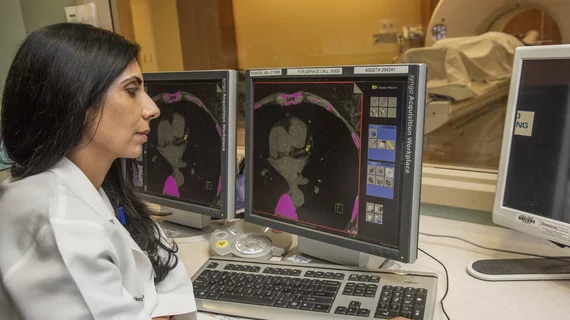Cardiac CT comparable to invasive angiography when assessing stable chest pain, new meta-analysis confirms
Coronary computed tomography angiography (CCTA) is a safe and effective alternative to invasive coronary angiography (ICA) when evaluating suspected coronary artery disease (CAD), according to a new meta-analysis published in the American Journal of Cardiology.[1] In some cases, in fact, cardiologists my prefer CCTA over ICA as their go-to modality of choice.
“CCTA is a noninvasive alternative tool for the diagnosis of obstructive CAD,” wrote first author Ahmad Al-Abdouh, MD, an assistant professor with the University of Kentucky College of Medicine, and colleagues. “This tool has been evaluated in randomized controlled trials (RCTs) in patients with stable chest pain and intermediate probability of CAD. However, there is uncertainty regarding its usefulness compared with ICA in reducing cardiovascular outcomes in this patient population.”
Al-Abdouh et al. examined data from three RCTs, including one study published in the New England Journal of Medicine in April 2022.[2] The group’s meta-analysis included outcomes from 5,393 patients who presented with stable chest pain.
Overall, the authors found that there were no significant differences between CCTA and ICA when it came to the rates of myocardial infarction, stroke, all-cause mortality or cardiovascular mortality. These findings, they wrote, were “consistent” with the 2021 Chest Pain Guidelines developed by the American Heart Association (AHA) and American College of Cardiology (ACC). The AHA/ACC guidelines recommended cardiac CT as a first-line imaging test for patients presenting with stable chest pain.
“This meta-analysis is consistent with the current guidelines and suggests that there is no difference between CCTA and ICA for stable chest pain evaluation in terms of myocardial infarction, stroke, all-cause mortality, or cardiovascular mortality,” the authors concluded. “The use of CCTA is a good alternative in patients with stable chest pain and intermediate pretest probability and may be preferable given it is a noninvasive tool.”
The researchers did note that the small number of RCTs included in their meta-analysis was a limitation, but they said that they made certain adjustments to their calculations to account for that fact.

